MARIANI’S
Virtual Gourmet
JUNE 12,
2016
NEWSLETTER
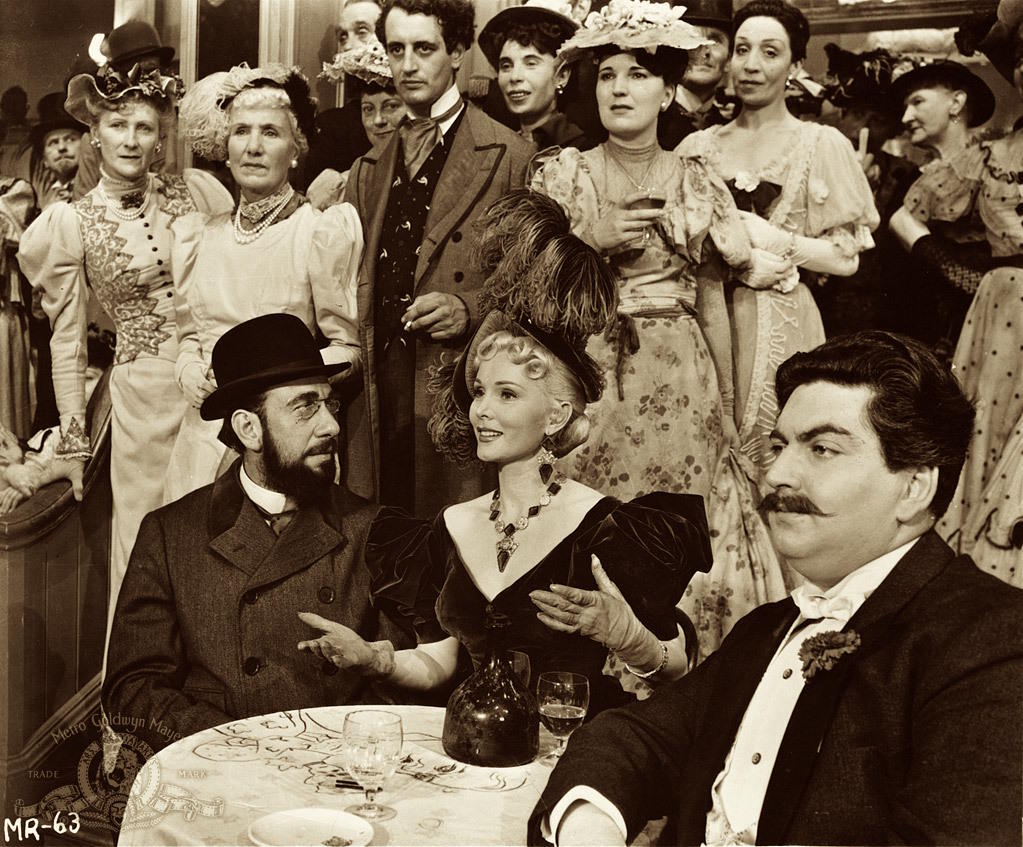
❖❖❖
IN THIS ISSUE
THE FARM TO TABLE FARCE
By John Mariani
NEW YORK CORNER
LA GAMELLE
By John Mariani
ANNOUNCEMENT:
On
June
24 at Ribalta Restaurant in NYC (from 2 PM-5
PM), I will be one of the
judges of PRIMO
DI MANHATTAN, sponsored
by Il Pastificio Di Martino di Gragnano and the Associazione
Italiana
Chef di New York (AICNY). Ten chefs will compete
to create the best
pasta and the winner
will be awarded $5000
and a trip to Gragnano, Italy, and be invited to
Le Strade della Mozzarella
2017 event in Italy.
❖❖❖
THE FARM TO TABLE FARCE
By John Mariani
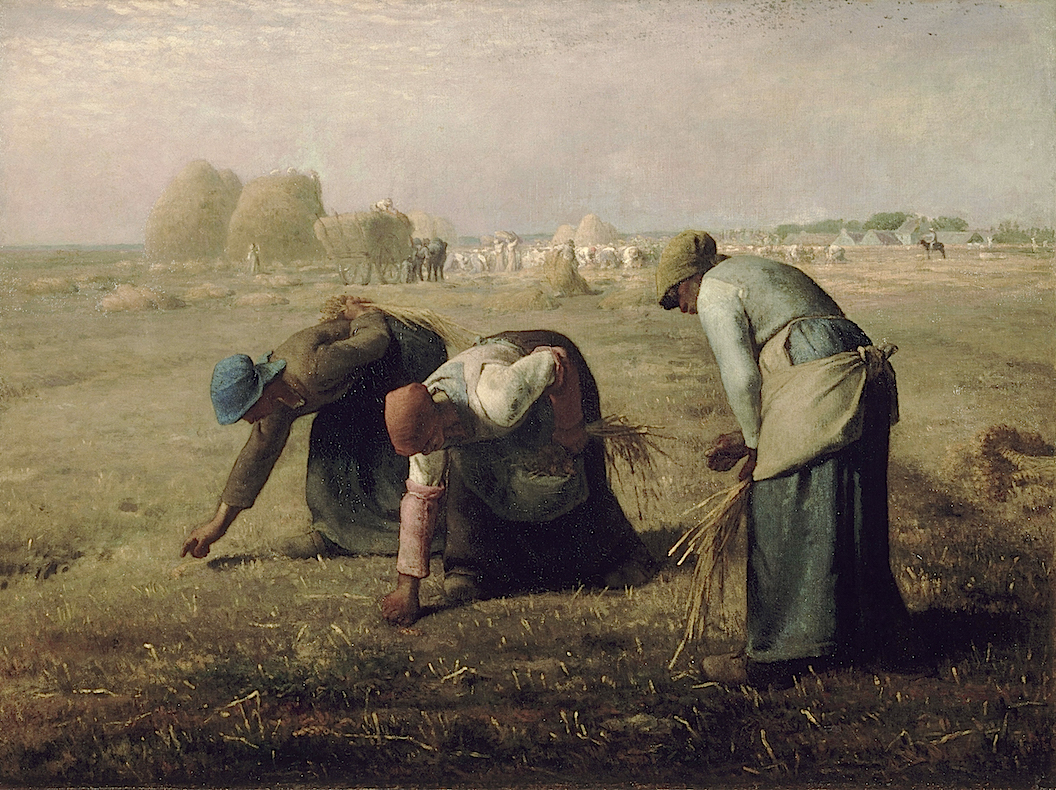
"Gleaners" (1857) by Jean-Francois Millet
When was the last time
you dined out in Paris, London, Rome, Madrid,
Buenos Aires, Mumbai or Hong Kong where the chef
or waiter came over to assure you that the food
was fresh? Or
that the ingredients came from two miles away? Or that
they refuse to serve anything unless it was grown
in the province?
For them it’s a matter of self-respect not
to need to utter such banalities, and they would
be insulted if a guest asked them such questions.
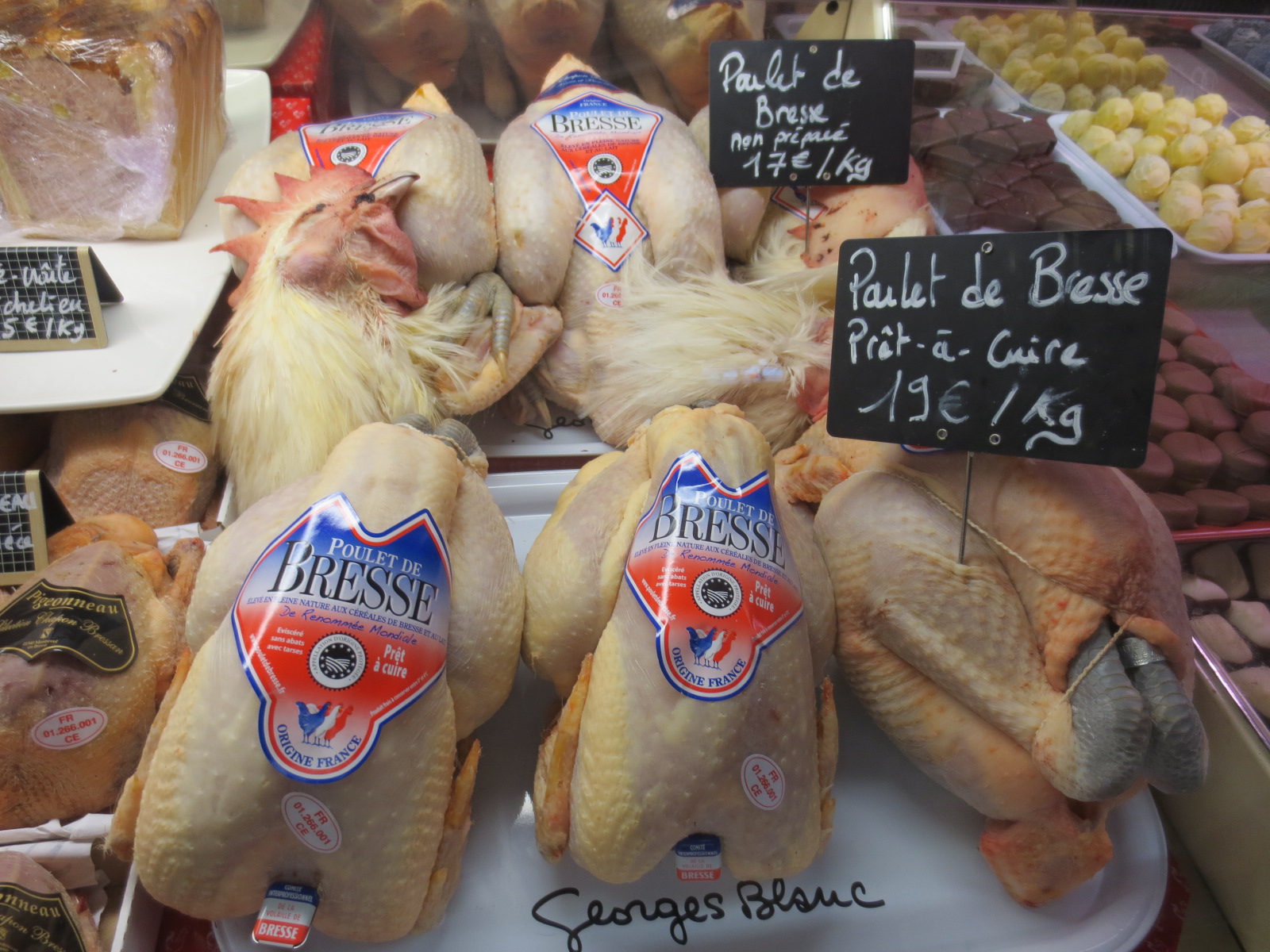 In good
restaurants outside the U.S. the chefs most
certainly pride themselves on the sources of their
finest ingredients, so that a French chef may list “poulet de Bresse”
(left) on
his menu or a London chef say the cheeses are from
British and Irish farms. Otherwise a guest can safely assume
that the basil in a pesto in
Liguria came from a nearby garden or that the squid
at a restaurant in Santorini swam in local waters
that morning.
Fine and dandy for those particular, easily
available seasonal ingredients.
In good
restaurants outside the U.S. the chefs most
certainly pride themselves on the sources of their
finest ingredients, so that a French chef may list “poulet de Bresse”
(left) on
his menu or a London chef say the cheeses are from
British and Irish farms. Otherwise a guest can safely assume
that the basil in a pesto in
Liguria came from a nearby garden or that the squid
at a restaurant in Santorini swam in local waters
that morning.
Fine and dandy for those particular, easily
available seasonal ingredients.
Why, then, do American chefs and
media insist on putting words like “fresh” next to
their vegetables and seafood and use the awkwardly
embarrassing phrase “farm to table”? If it
once had a meaning at all, it might date back to the
1970s, when Alice Waters began sourcing her
provender from local farms in Northern California,
like the now-famous Chino Ranch (below). Listing
one’s sources lends a certain credibility and
seriousness to a restaurant as well as a nod of
cordiality towards the growers and producers. But, if
all tomatoes grow from soil on farms, as do bananas,
kumquats, and zucchini, and, if lamb and steers and
chickens all come from farms, what else would you
expect?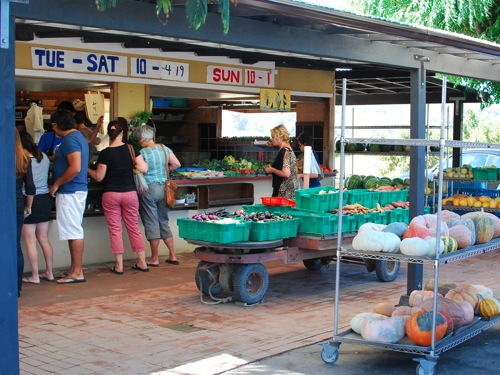
Nevertheless,
the
phrase is trotted out every time a food writer or p.r.
agent needs an easy cliché to describe a chef who
proclaims he buys most of his ingredients within a
certain radius outside his restaurant—it could be
ten miles, fifty miles, or a hundred miles. In the
case of the highly publicized and very talented Sean
Brock (left),
chef of two Husk restaurants, in Charleston and
Nashville, the idea gets a bit precious: Brock
insists, “If it doesn’t come from the South,
it’s not coming through the door.” He
even banned olive oil from his kitchens and makes
his own salt on the 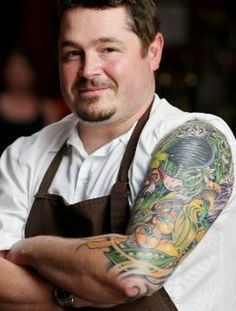 roof of his
restaurants. It should be noted, however, that Brock
goes way off his self-imposed reservation by selling
European and California wines, when he could hunker
down and ferret out good quality wines from
Virginia, Georgia, and even Texas.
roof of his
restaurants. It should be noted, however, that Brock
goes way off his self-imposed reservation by selling
European and California wines, when he could hunker
down and ferret out good quality wines from
Virginia, Georgia, and even Texas.
This begs two questions: Which
states actually qualify as “Southern,” especially
since the oft-cited Mason-Dixon Line merely resolved
a pre-Revolutionary War dispute involving
three Mid-Atlantic colonies—Pennsylvania, Maryland
and Delaware—but never divided the country into
North and South.
Does Brock mean any state that joined the
Confederacy? Is
Texas a Southern state? (As they say in Louisiana, "The South starts
north of here.") It’s all just a
geographical fantasy.
Second, what makes any ingredient from a
designated region the best available, which is what
good chefs are supposedly really after, not just
tomatoes grown in Minnesota or melons grown in
Alaska?
The term "locavorism" was coined
in 2005 during the World Environmental Day in San
Francisco by Jessica Prentice, Jen Maiser, Sage Van
Wing and DeDe Sampson, who insisted that buying and
consuming food not obtained locally is a process
that imperils "our environment, our health, our
communities, and out taste buds." Their goal was "to
eat from a 100 mile radius of San Francisco of our
homes. Failing that, we will attempt to eat
foods that come from within our state, or are
purchased directly from small scale farmers
elsewhere in the world," which makes the original
intent meaningless.
But given the
miracle of FedEx and DHL, why shouldn’t a chef in
Georgia sell Maine lobsters or one in Boston sell
Florida stone crabs just because they aren’t local? Is a chef
committed to “farm to table” going to  serve second-rate
artichokes or third-rate farm-raised seafood solely
because it comes from a specific local region?
serve second-rate
artichokes or third-rate farm-raised seafood solely
because it comes from a specific local region?
Yet, despite the hype about
what has become a hackneyed phrase, Travel &
Leisure magazine recently published an article
on America’s best farm-to-table restaurants,
researched by asking local food critics which they’d
choose.
Writes
the article’s editor in an attempt to resuscitate
the phrase: “The farm-to-table movement may be
decades old, but recent heightened attention towards
issues like climate change and health has given rise
to a new generation of chefs who are redefining what
that oft-abused phrase means. In an era where fast
food chains are hawking the farm-to-table trend,
consumers are left feeling that every restaurant is
green to some degree. These 50 establishments—plus
Washington D.C.—stand out from the pack by not only
creating exciting innovative cuisine with a locally
sourced menu, but also by applying that same
eco-minded culinary philosophy to every aspect of
the operation. He goes on: “Considering that the
average food item in America has traveled 1,500
miles from the farm to your plate, according to
Worldwatch Institute, eating local—for your health,
the environment, and your taste buds—is only
logical.”
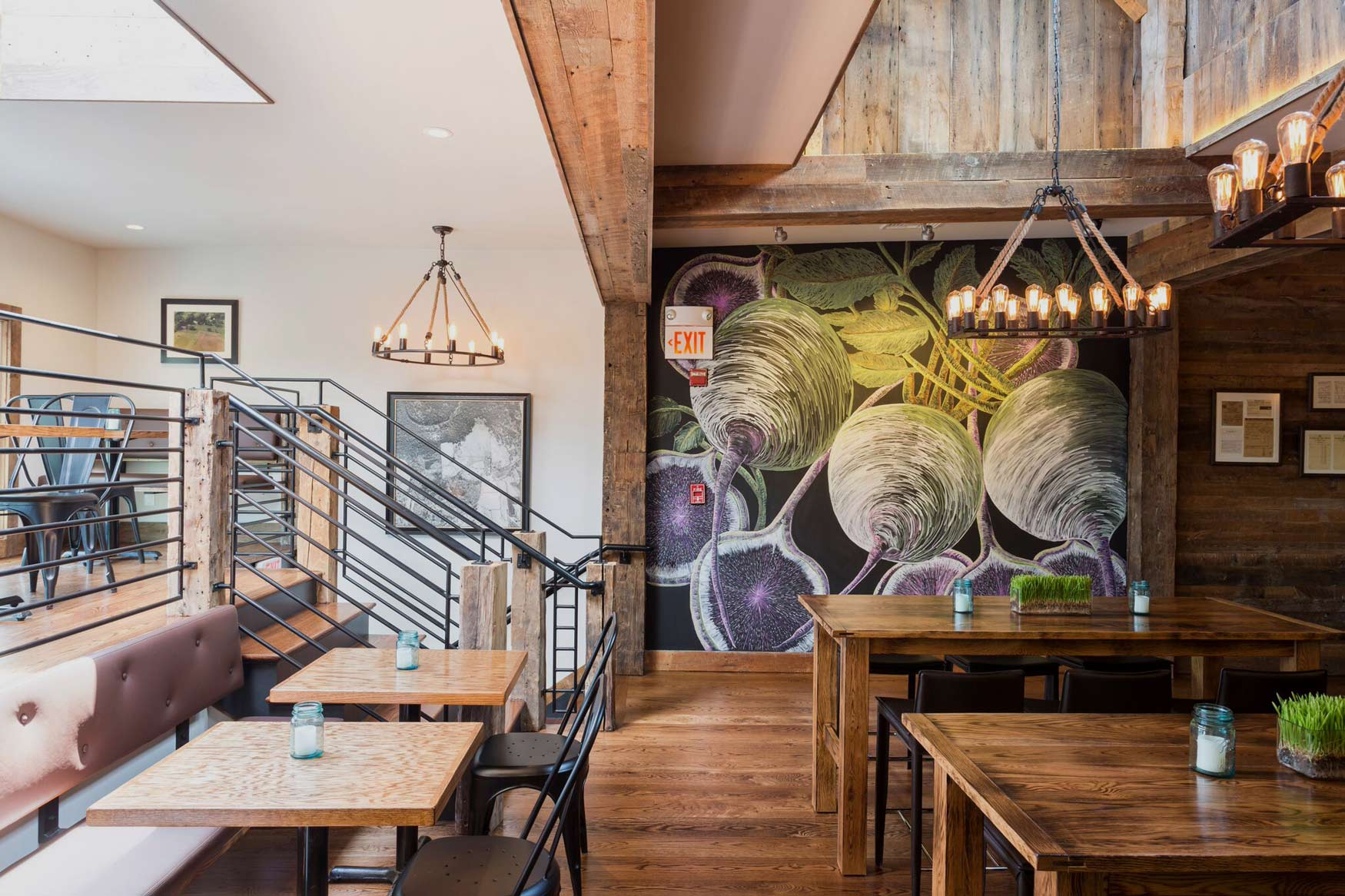 Let’s skip
over the dubious statements that foods shipped in
from less than 1,500 miles away are more healthful
and not damaging to the environment, although the best
locally grown food may have certain nutritious
advantages over lower quality foods grown far away. Let’s
look at a few of the restaurants T&L
praises for their commitment to locavorism--without
implying in any way that the chef is not serving
wonderful food.
Let’s skip
over the dubious statements that foods shipped in
from less than 1,500 miles away are more healthful
and not damaging to the environment, although the best
locally grown food may have certain nutritious
advantages over lower quality foods grown far away. Let’s
look at a few of the restaurants T&L
praises for their commitment to locavorism--without
implying in any way that the chef is not serving
wonderful food.
At Trio’s in Little Rock,
Arkansas, the menu lists crab cakes and Gulf shrimp,
despite the Gulf being more than 400 miles away.
They also insist their tortillas are made with
“local flour” yet serve French Brie with a mango
chutney.
Back Forty
(left) in
Greenwich, Connecticut, prints a creed that notably
claims, “We receive pasture raised whole animals
from practicing organic or Certified Organic local
farms and butcher them ourselves. . . . We only
buy in season organic produce from local farms,”
then says their organic spices, dried herbs and teas
are from Mountain Rose Herbs in Eugene, Oregon, and
“We use only Himalayan Pink Salt.” (Of course, many
of these restaurants boast of stereotypical decors
using reclaimed local barn wood.)
The oddly named a(Muse) in
Rehoboth Beach, Delaware, serves foie gras from the
Hudson Valley, bacon from Tennessee and pork from
the Berkshires—all pretty remote places from
Rehoboth to claim as local. Miami’s LoKal (below) insists,
“Owner
Matthew Kuscher’s commitment to quality is unmatched
as he will be tapping Floridian farmers, dairies and
brewers in order to highlight the bounty of
products, goods and ingredients available in the
Sunshine State. In plain English, LoKal will be as
local as local gets.”
So that’s why they use Gruyère and Monterey
Jack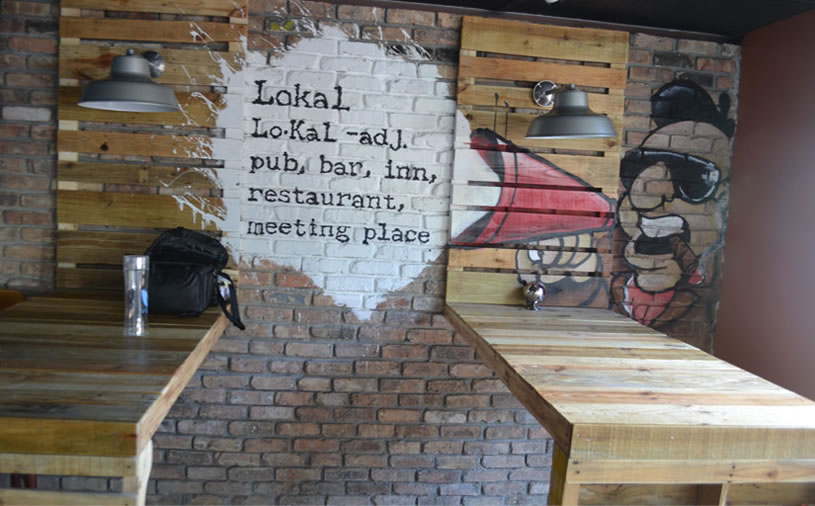 cheese and
import Scottish salmon?
cheese and
import Scottish salmon?
Luna in Grand Rapids, Michigan,
cooks up Hawaiian ono; Birchwood Café in Minneapolis
serves tilapia in its Indonesian stew. The problem
is it's nearly impossible to obtain U.S. bred
tilapia, a tropical fish whose supply is almost
entirely coming in either frozen from China or farm
bred in Central America.
Persimmon in
Providence, Rhode Island, serves Spanish octopus and
royal white sturgeon caviar from California. And The Dabney in
Washington DC, which just made Food & Wine's
list of Best New Restaurants 2016, for sourcing
"100% of its ingredients from the mid-Atlantic,"
which somehow include Anson Mills grits from South
Carolina, Rainey's Dream Camembert from North
Carolina, Whistle Pig Farm pork loin from Vermont,
and, on their current wine list, not a single
bottle from the mid-Atlantic.
Not for a moment am I calling
into question the commitment, quality and serious
cooking being done at any of these restaurants. But
to aggrandize oneself as being noble about serving
farmed catfish rather than wild sea bass strikes me
as the wrong field to plow. The real
irony is that the most hyped chef of the past
decade, David Chang, couldn’t care less about
locavorism, as long as he’s getting the quality he
wants. At his award-winning Ko in NYC he serves caviar from Idaho, bee
pollen from Connecticut, green-tea matcha
from Japan, lamb from Pennsylvania and Calabrian
chilies.
If one of
these chefs were asked to be general manager of,
say, the Chicago Symphony, would he hire only
musicians from the Windy City? Or if he became
owner of the NY Yankees, would he hire only players
born and bred in NYC, with as many as possible from
the Bronx? Somehow I doubt it. So, too,
there’s
nothing wrong about locavorism that stepping back
from it won’t make better. Mileage does not define
quality, and a greenhouse is not always the place to
find the best of anything.
❖❖❖
By John Mariani
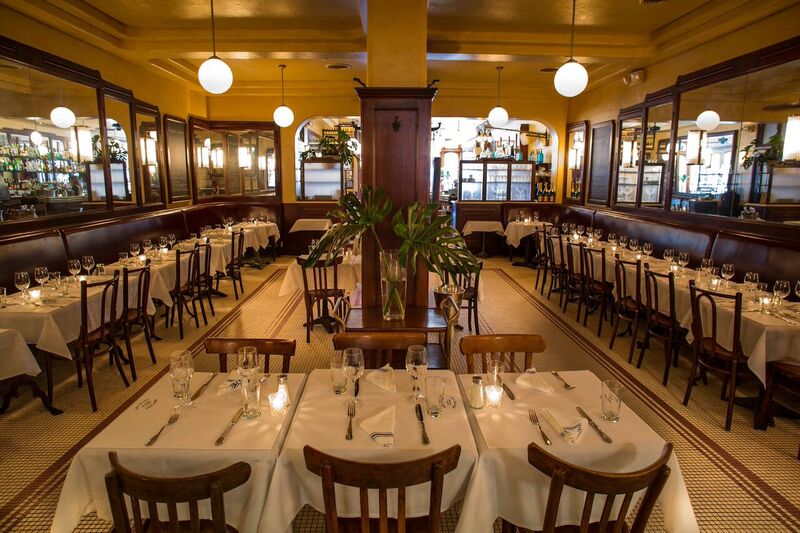
La Gamelle
241 Bowery (near Prince
Street)
212-388-0052
www.lagamellenyc.com
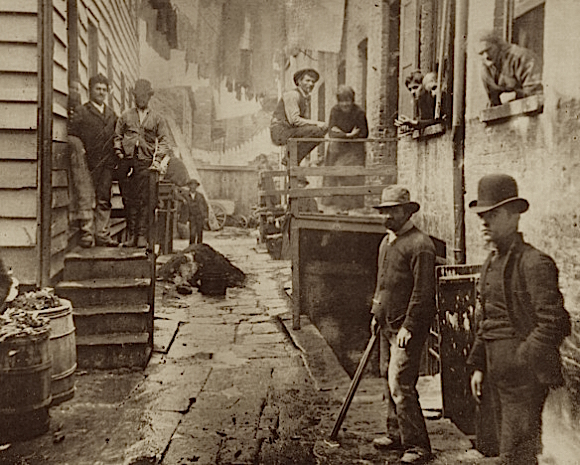 Though
now thoroughly gentrified, the Bowery (left)was
once synonymous with downtown grit. As the old
song goes,
Though
now thoroughly gentrified, the Bowery (left)was
once synonymous with downtown grit. As the old
song goes,
The
Bow'ry, the Bow'ry!
They say such things,
And they do strange things
On the Bow'ry! The Bow'ry!
I'll never go there anymore!
New
restaurants are usually the first to venture
onto once derelict streets like The Bowery, and
now that the New Museum has become a draw there,
with Daniel Boulud’s poupualr DBGB next door,
the lights are on everywhere, none more
charmingly than at La Gamelle (French for a bowl
or lunch pail).
Open a little over a year, the pleasantly
sized bar and two dining rooms have all the
trappings you’d hope for in a Parisian-style
bistro, from the tile floors and banquettes to
the zinc bar and tables covered with both cloths
and paper.
Many of the furnishings were brought over
from France, and the overhead lighting and
ambient colors of the place makes it seems like
it’s been this way for decades.
Initial reports on the food
were muted, but a year later, La Gamelle has hit
its stride now that owner Dimitri
Vlahakis has brought in Chef Denis Kuc, who’s
worked at BLT Bar
& Grill and BLT Fish, Dovetail,
The Modern, and Artisanal, and consulting chef
Michael Burbella, formerly of Gramercy Tavern
and Gotham Bar & Grill—all among NYC’s best
kitchens.
The menu is still solidly that of a
French bistro of a kind no one can possibly tire
of, with novel additions each night in the same
style.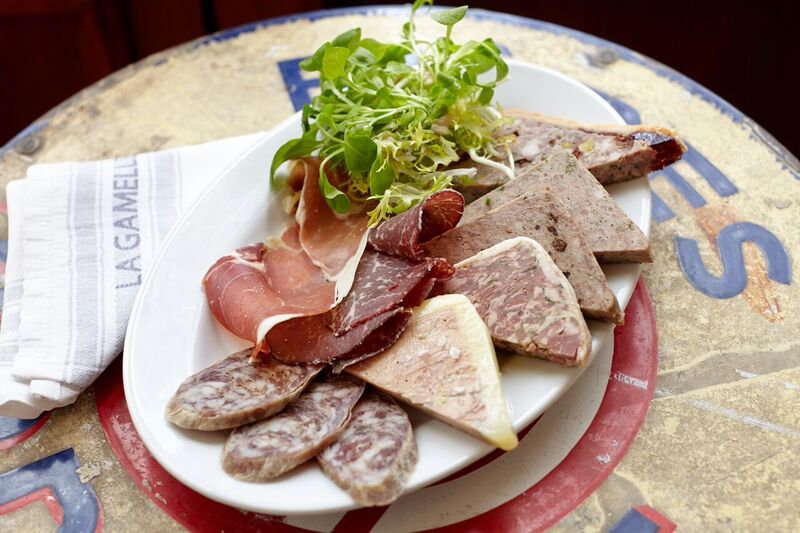
A new Master Sommelier, Harold Toussaint,
founder of the restaurant’s Wine School, has
added measurably to the wine list, so it’s well
worth your while to consult him before ordering.
He’s got some rare bottlings back there at reasonable
prices, although on the printed list wines by
the glass are sky-high, like a Château
La Grange Clinet 2009 that
sells for about $12 a bottle in a store goes for
a whopping $13 by the glass at La Gamelle and
$48 for the bottle.
Our
table ordered a generous platter of housemade
charcuterie ($37) that included a hearty pȃté de
champagne, creamy foie gras, pâté en croûte, saucisson
sec, Serrano ham, and pâté musketeer (right),
with two kinds of good bread and butter, which
went well with a lovely summer’s rosé wine. Carabiñero
shrimp [market price] are grilled and nicely
seared while the shrimps’ texture remained
velvety, drizzled with olive oil with frisée
lettuce. Steaming
hot escargots
($12/$22) had an assertive garlic-parsley
butter, which, let’s face it, is the whole
reason to eat snails, while roasted octopus
citronette
($18) took well to the lemon and olive
oil dressing.
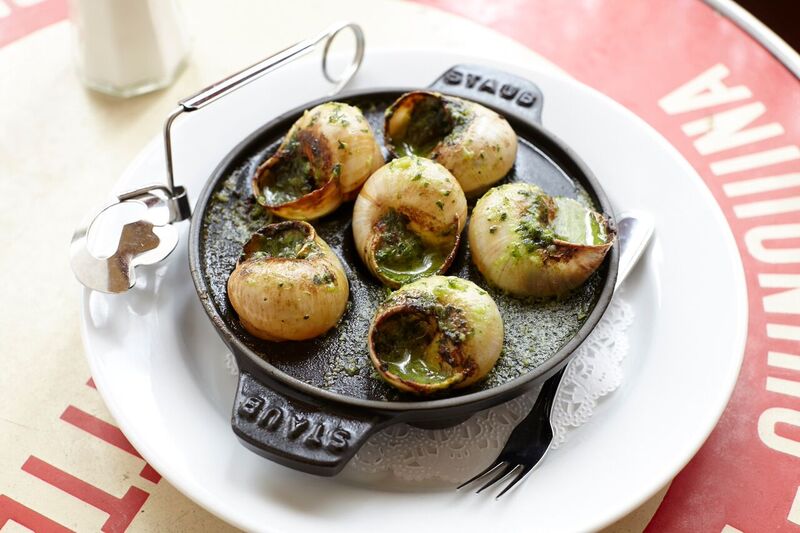 There is a selection
of moules
frites ($24), and we sampled a main course
bowl of well-sized (meaning not too large)
mussels in a white wine, saffron, celery,
shallots, and garlic cream broth that was all
right but should have had more depth. Onion soup
gratinée ($12) had plenty of depth and the
onions were well caramelized beneath the browned
bubbly cheese.
There is a selection
of moules
frites ($24), and we sampled a main course
bowl of well-sized (meaning not too large)
mussels in a white wine, saffron, celery,
shallots, and garlic cream broth that was all
right but should have had more depth. Onion soup
gratinée ($12) had plenty of depth and the
onions were well caramelized beneath the browned
bubbly cheese.
There was a similar sweetness
to a hefty platter of boneless short ribs ($34),
braised for four hours and served with sautéed
Swiss chard, beet and horseradish relish, and
baby carrots, while the hanger steak ($28) had
just the right chewiness that both characterizes
and makes this French cut so delicious, served
with a well-made bordelaise, rich bone marrow
and perfectly wrought pommes
frites.
Terrified we might not have enough pommes
frites, we ordered another batch ($9) for
the table and left very few behind. 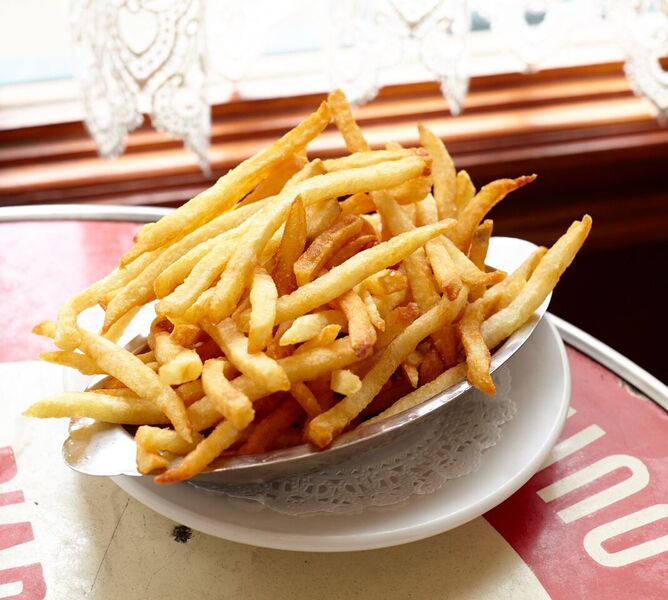
Duck confit is too easy to
make and then leave hanging around in the
refrigerator, but La Gamelle’s was obviously
made that day, with just enough cooking fat
(without being greasy) suffused into the meaty
duck meat ($24), served with buttery roesti
potatoes done till tender in a skillet. Grilled
asparagus ($9) were glazed with truffle essence
and shaved Parmigiano.
Pastry
chef Richard Chirol stays with classic French
desserts (all $10), including a nougat
glacé meringue with crème fraîche frozen mousse,
caramelized nuts, confit of fruit, and raspberry
sauce; plump profiteroles in puff pastry with
vanilla ice cream and warm chocolate sauce; even
good old-fashioned île
flotante of egg white meringues bobbing in
crème anglaise.
The tart Tatin of caramelized apples with
crème fraîche was in need of more caramelization
and surface brittle.
I must note that on
Thursdays, Fridays and Saturdays La Gamelle has
first-rate jazz with a Bossa Nova swing that
never intrudes on dinner conversation. Then
again, the group is so good, you’ll probably
stop talking and just listen.
The fact that La Gamelle has
not chosen to go trendy, neither in its look or
food, as so many neighboring restaurants have,
is applaudable for all sorts of reasons, not
least because Parisian bistros never go out of
style as long as they go out of their way to
please their guests.
Open
nightly for dinner, Sat.&Sun. for brunch;
$35 Gallerists’
Menu, offered Mon.-Fri., 5pm-7pm, includes 3
three courses drawn from the complete menu
(appetizer, main and dessert); for an
additional $10, guests are treated to some of
the finest wines on the list, not typically
available by the glass.
❖❖❖

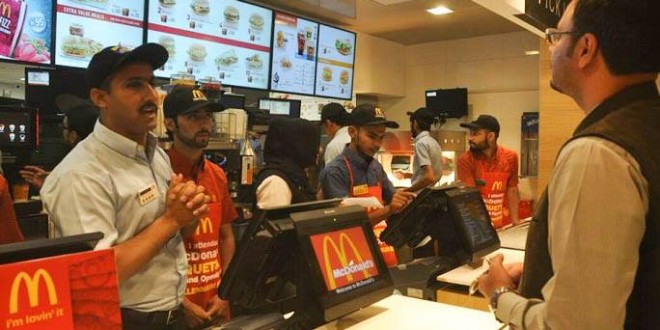 RESTAURANT
REVIEWS FROM ALL OVER
RESTAURANT
REVIEWS FROM ALL OVER
After McDonald's opened its first location in the Pakistani city of Quetta (left), reputedly home base for the Taliban's ruling council, senior militant commander Ehsanullah Ehsan told NBC that the food is terrible: "Hahahaha, so you are asking me about McDonald's food. Yes, I know McDonald's and its food but we will never eat it. We don't even consider it as a food," adding that his fighters lived in "rough, tough mountainous areas" and need energy and power "to fight against the enemy," as provided by their usual ration of mutton and rice.
Any of John Mariani's books below may be ordered from amazon.com.
 The
Hound in Heaven (21st Century Lion Books)
is a novella, and for anyone who loves dogs,
Christmas, romance, inspiration, even the supernatural, I
hope you'll find this to be a treasured favorite.
The story concerns how, after a New England teacher,
his wife and their two daughters adopt a stray puppy found
in their barn in northern Maine, their lives seem full of
promise. But when tragedy strikes, their wonderful dog
Lazarus and the spirit of Christmas are the only things
that may bring his master back from the edge of
despair.
The
Hound in Heaven (21st Century Lion Books)
is a novella, and for anyone who loves dogs,
Christmas, romance, inspiration, even the supernatural, I
hope you'll find this to be a treasured favorite.
The story concerns how, after a New England teacher,
his wife and their two daughters adopt a stray puppy found
in their barn in northern Maine, their lives seem full of
promise. But when tragedy strikes, their wonderful dog
Lazarus and the spirit of Christmas are the only things
that may bring his master back from the edge of
despair. WATCH THE VIDEO!
“What a huge surprise turn this story took! I was completely stunned! I truly enjoyed this book and its message.” – Actress Ali MacGraw
“He had me at Page One. The amount of heart, human insight, soul searching, and deft literary strength that John Mariani pours into this airtight novella is vertigo-inducing. Perhaps ‘wow’ would be the best comment.” – James Dalessandro, author of Bohemian Heart and 1906.
“John Mariani’s Hound in Heaven starts with a well-painted portrayal of an American family, along with the requisite dog. A surprise event flips the action of the novel and captures us for a voyage leading to a hopeful and heart-warming message. A page turning, one sitting read, it’s the perfect antidote for the winter and promotion of holiday celebration.” – Ann Pearlman, author of The Christmas Cookie Club and A Gift for my Sister.
“John Mariani’s concise, achingly beautiful novella pulls a literary rabbit out of a hat – a mash-up of the cosmic and the intimate, the tragic and the heart-warming – a Christmas tale for all ages, and all faiths. Read it to your children, read it to yourself… but read it. Early and often. Highly recommended.” – Jay Bonansinga, New York Times bestselling author of Pinkerton’s War, The Sinking of The Eastland, and The Walking Dead: The Road To Woodbury.
“Amazing things happen when you open your heart to an animal. The Hound in Heaven delivers a powerful story of healing that is forged in the spiritual relationship between a man and his best friend. The book brings a message of hope that can enrich our images of family, love, and loss.” – Dr. Barbara Royal, author of The Royal Treatment.
 |
The Encyclopedia of American Food and Drink by John F. Mariani (Bloomsbury USA, $35) Modesty forbids me to praise my own new book, but let me proudly say that it is an extensive revision of the 4th edition that appeared more than a decade ago, before locavores, molecular cuisine, modernist cuisine, the Food Network and so much more, now included. Word origins have been completely updated, as have per capita consumption and production stats. Most important, for the first time since publication in the 1980s, the book includes more than 100 biographies of Americans who have changed the way we cook, eat and drink -- from Fannie Farmer and Julia Child to Robert Mondavi and Thomas Keller. "This book is amazing! It has entries for everything from `abalone' to `zwieback,' plus more than 500 recipes for classic American dishes and drinks."--Devra First, The Boston Globe. "Much needed in any kitchen library."--Bon Appetit. |
"Eating Italian will never be the same after reading John Mariani's entertaining and savory gastronomical history of the cuisine of Italy and how it won over appetites worldwide. . . . This book is such a tasteful narrative that it will literally make you hungry for Italian food and arouse your appetite for gastronomical history."--Don Oldenburg, USA Today. "Italian
restaurants--some good, some glitzy--far
outnumber their French rivals. Many of
these establishments are zestfully described
in How Italian Food Conquered the World, an
entertaining and fact-filled chronicle by
food-and-wine correspondent John F.
Mariani."--Aram Bakshian Jr., Wall Street
Journal.
"Equal parts
history, sociology, gastronomy, and just
plain fun, How Italian Food Conquered the
World tells the captivating and delicious
story of the (let's face it) everybody's
favorite cuisine with clarity, verve and
more than one surprise."--Colman Andrews,
editorial director of The Daily
Meal.com. "A fantastic and fascinating
read, covering everything from the influence
of Venice's spice trade to the impact of
Italian immigrants in America and the
evolution of alta cucina. This book will
serve as a terrific resource to anyone
interested in the real story of Italian
food."--Mary Ann Esposito, host of PBS-TV's
Ciao
Italia. "John Mariani has written the
definitive history of how Italians won their
way into our hearts, minds, and
stomachs. It's a story of pleasure over
pomp and taste over technique."--Danny Meyer,
owner of NYC restaurants Union Square
Cafe, The Modern, and Maialino.
|
 |
 |
 |
 |
 |
 |
 |
 |
 Everett Potter's Travel Report:
Everett Potter's Travel Report: 
 Eating Las
Vegas JOHN CURTAS has been covering
the Las Vegas food and restaurant scene
since 1995. He is the co-author of EATING LAS
VEGAS – The 50 Essential Restaurants (the
fourth edition of which will be published in
early 2016), as well as the author of the Eating Las
Vegas web site: www.eatinglasvegas.
He can also be seen every Friday morning as
the “resident foodie” for Wake Up With the
Wagners on KSNV TV (NBC) Channel 3 in
Las Vegas.
Eating Las
Vegas JOHN CURTAS has been covering
the Las Vegas food and restaurant scene
since 1995. He is the co-author of EATING LAS
VEGAS – The 50 Essential Restaurants (the
fourth edition of which will be published in
early 2016), as well as the author of the Eating Las
Vegas web site: www.eatinglasvegas.
He can also be seen every Friday morning as
the “resident foodie” for Wake Up With the
Wagners on KSNV TV (NBC) Channel 3 in
Las Vegas.

MARIANI'S VIRTUAL GOURMET
NEWSLETTER is published weekly. Editor/Publisher: John
Mariani.
Editor: Walter Bagley. Contributing Writers: Christopher Mariani,
Robert Mariani, Misha
Mariani,
John A. Curtas, Edward Brivio, Mort Hochstein,
Andrew Chalk, Dotty Griffith and Brian Freedman. Contributing
Photographers: Galina Dargery, Bobby
Pirillo. Technical Advisor: Gerry McLoughlin.
To un-subscribe from this newsletter,click here.
© copyright John Mariani 2016

